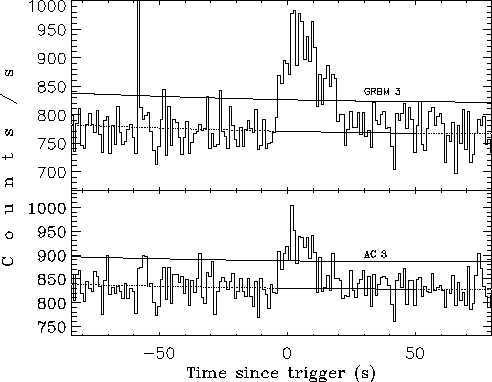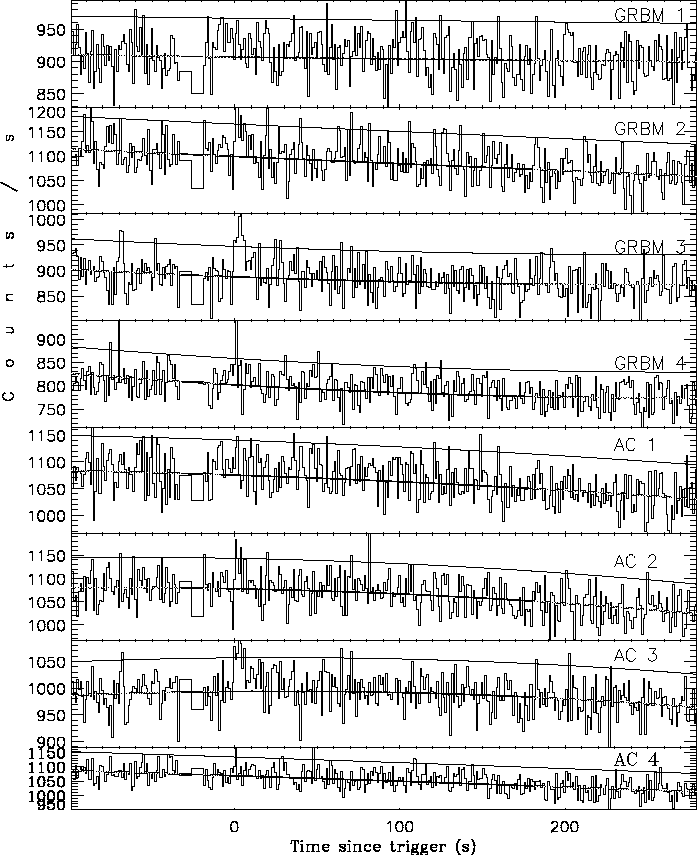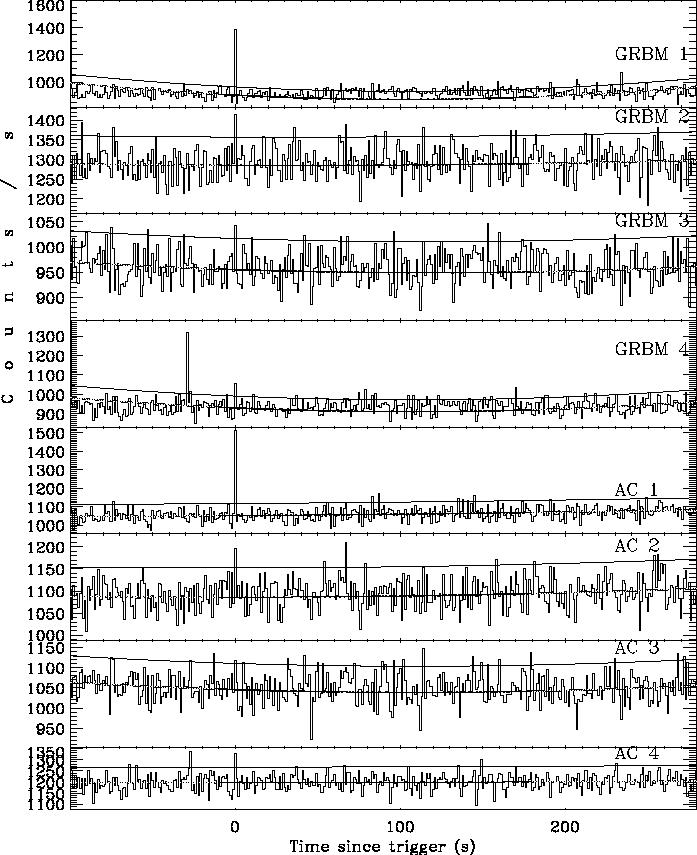



Next: Automatic computation of the
Up: The Late SWTCs
Previous: HR Threshold
Contents
Figure:
Time profiles of NTB 010518 in both energy bands of unit 3,
that detected it: this burst did not trigger the on-board
logic, because too faint; nevertheless, it triggered the SWTC 4,
making it possible to discover the faint X-ray counterpart in the
WFC 2 (GCN 1062).
 |
In figg. ![[*]](crossref.png) ,
, ![[*]](crossref.png) and
and ![[*]](crossref.png) some examples of NTBs detected with late SWTCs are shown.
In order to give an idea of the various brightnesses in the
different units and energy ranges, the background level and
the +2
some examples of NTBs detected with late SWTCs are shown.
In order to give an idea of the various brightnesses in the
different units and energy ranges, the background level and
the +2 level over the background are plotted, as they
are automatically calculated by the GRB quest:
the NTB980511 (fig.
level over the background are plotted, as they
are automatically calculated by the GRB quest:
the NTB980511 (fig. ![[*]](crossref.png) ) and NTB 961116 (fig.
) and NTB 961116 (fig. ![[*]](crossref.png) )
have been caught only with the off-line quest (at that time
the on-line quest was not operating yet), while the NTB010518
(fig.
)
have been caught only with the off-line quest (at that time
the on-line quest was not operating yet), while the NTB010518
(fig. ![[*]](crossref.png) ) was detected within a few hours after its occurrence.
) was detected within a few hours after its occurrence.
Figure:
Time profiles of NTB 980511, also detected by BATSE
(# 6753); this GRB triggered SWTC 3, thanks to the counts
in the units nn. 2 and 3, the two brightest ones (this agrees
with the BATSE direction, 
 ,
, 
 ).
A small data gap is visible
).
A small data gap is visible  s before the GRB.
The background fits and the +2
s before the GRB.
The background fits and the +2 levels are
overplotted, as well. The two intervals around the burst, used for
fitting, are highlighted.
levels are
overplotted, as well. The two intervals around the burst, used for
fitting, are highlighted.
 |
The case of GRB010518 (fig. ![[*]](crossref.png) ) is particularly important:
it happened on May 18, 2001, UT 06:43:10,
lasting
) is particularly important:
it happened on May 18, 2001, UT 06:43:10,
lasting  s in the 40-700 keV range and
s in the 40-700 keV range and
 s in the WFC range (2-28 keV): this burst, in the FOV
of WFC 2, was too faint to trigger the GRBM on-board logic, but
it triggered SWTC 4 of the on-line quest, which
automatically alerted the duty scientists at the BeppoSAX-SOC:
indeed, the WFC 2 images localized a diffuse, unknown faint faiding
source, whose position was distributed with an error radius of
s in the WFC range (2-28 keV): this burst, in the FOV
of WFC 2, was too faint to trigger the GRBM on-board logic, but
it triggered SWTC 4 of the on-line quest, which
automatically alerted the duty scientists at the BeppoSAX-SOC:
indeed, the WFC 2 images localized a diffuse, unknown faint faiding
source, whose position was distributed with an error radius of

 a few days later (GCN 1062) and not earlier, because
of the long time needed to image such a faint burst
(see fig.
a few days later (GCN 1062) and not earlier, because
of the long time needed to image such a faint burst
(see fig. ![[*]](crossref.png) ).
).
The NTB980511 (fig. ![[*]](crossref.png) ) occurred at UT 01:55:26 and
did not trigger the on-board logic, because too faint;
it nevertheless triggered the SWTC 3; BATSE, that detected it
as well (trig. 6753), gave an estimate of the arrival direction,
which is consistent with the pointing directions of the
two brightest GRBM units, 2 and 3:
in the BeppoSAX local frame of reference,
) occurred at UT 01:55:26 and
did not trigger the on-board logic, because too faint;
it nevertheless triggered the SWTC 3; BATSE, that detected it
as well (trig. 6753), gave an estimate of the arrival direction,
which is consistent with the pointing directions of the
two brightest GRBM units, 2 and 3:
in the BeppoSAX local frame of reference, 
 ,
,

 (statistical error radius of
(statistical error radius of 
 ).
).
Eventually, the NTB961116 (fig. ![[*]](crossref.png) ),
occurred at UT 20:33:09, triggered the
SWTC 2 in the units 1 and 2, and it was a short duration burst:
very unfortunately, since a spike triggered the on-board logic just
100 s earlier, the HTR counts stopped exactly 2 s before the burst,
thus depriving us of the knowledge of its ms temporal structure.
),
occurred at UT 20:33:09, triggered the
SWTC 2 in the units 1 and 2, and it was a short duration burst:
very unfortunately, since a spike triggered the on-board logic just
100 s earlier, the HTR counts stopped exactly 2 s before the burst,
thus depriving us of the knowledge of its ms temporal structure.
Figure:
Time profiles of the short NTB 961116;
this GRB triggered SWTC 2 in the units nn. 1 and 2.
The background fits and the +2 levels are overplotted, as well.
The two intervals around the burst, used for fitting, are highlighted.
The presence of a spike at
levels are overplotted, as well.
The two intervals around the burst, used for fitting, are highlighted.
The presence of a spike at  s little biases the fit in the cases
of GRBM1 and GRBM4; this spike triggered the on-board logic ``just too
early'', preventing the GRBM from acquiring HTR data of the NTB.
s little biases the fit in the cases
of GRBM1 and GRBM4; this spike triggered the on-board logic ``just too
early'', preventing the GRBM from acquiring HTR data of the NTB.
 |




Next: Automatic computation of the
Up: The Late SWTCs
Previous: HR Threshold
Contents
Cristiano Guidorzi
2003-07-31


![[*]](crossref.png) ,
, ![[*]](crossref.png) and
and ![[*]](crossref.png) some examples of NTBs detected with late SWTCs are shown.
In order to give an idea of the various brightnesses in the
different units and energy ranges, the background level and
the +2
some examples of NTBs detected with late SWTCs are shown.
In order to give an idea of the various brightnesses in the
different units and energy ranges, the background level and
the +2![]() level over the background are plotted, as they
are automatically calculated by the GRB quest:
the NTB980511 (fig.
level over the background are plotted, as they
are automatically calculated by the GRB quest:
the NTB980511 (fig. ![[*]](crossref.png) ) and NTB 961116 (fig.
) and NTB 961116 (fig. ![[*]](crossref.png) )
have been caught only with the off-line quest (at that time
the on-line quest was not operating yet), while the NTB010518
(fig.
)
have been caught only with the off-line quest (at that time
the on-line quest was not operating yet), while the NTB010518
(fig. ![[*]](crossref.png) ) was detected within a few hours after its occurrence.
) was detected within a few hours after its occurrence.

![[*]](crossref.png) ) is particularly important:
it happened on May 18, 2001, UT 06:43:10,
lasting
) is particularly important:
it happened on May 18, 2001, UT 06:43:10,
lasting ![[*]](crossref.png) ).
).
![[*]](crossref.png) ) occurred at UT 01:55:26 and
did not trigger the on-board logic, because too faint;
it nevertheless triggered the SWTC 3; BATSE, that detected it
as well (trig. 6753), gave an estimate of the arrival direction,
which is consistent with the pointing directions of the
two brightest GRBM units, 2 and 3:
in the BeppoSAX local frame of reference,
) occurred at UT 01:55:26 and
did not trigger the on-board logic, because too faint;
it nevertheless triggered the SWTC 3; BATSE, that detected it
as well (trig. 6753), gave an estimate of the arrival direction,
which is consistent with the pointing directions of the
two brightest GRBM units, 2 and 3:
in the BeppoSAX local frame of reference, ![]()
![]() ,
,
![]()
![]() (statistical error radius of
(statistical error radius of ![]()
![]() ).
).
![[*]](crossref.png) ),
occurred at UT 20:33:09, triggered the
SWTC 2 in the units 1 and 2, and it was a short duration burst:
very unfortunately, since a spike triggered the on-board logic just
100 s earlier, the HTR counts stopped exactly 2 s before the burst,
thus depriving us of the knowledge of its ms temporal structure.
),
occurred at UT 20:33:09, triggered the
SWTC 2 in the units 1 and 2, and it was a short duration burst:
very unfortunately, since a spike triggered the on-board logic just
100 s earlier, the HTR counts stopped exactly 2 s before the burst,
thus depriving us of the knowledge of its ms temporal structure.
